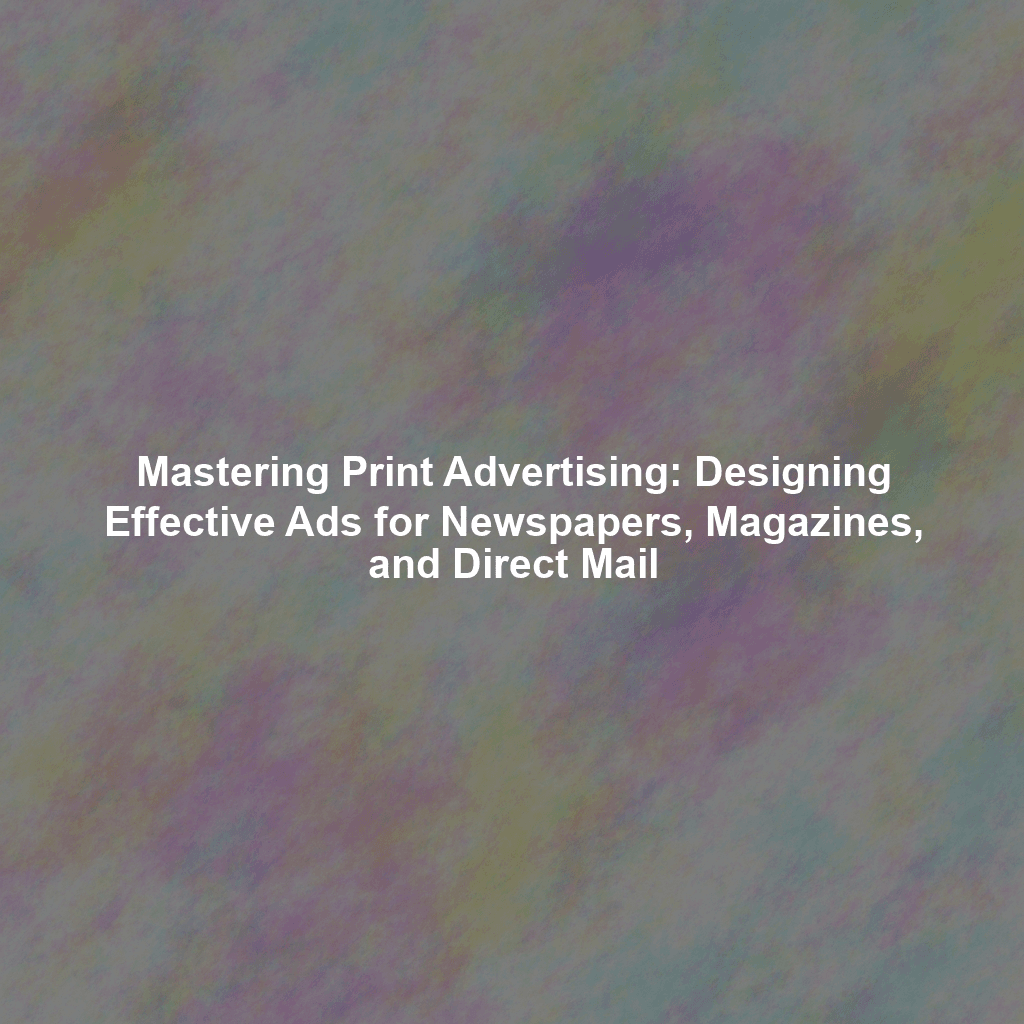In today’s digital-first world, it’s easy to overlook the power of traditional print advertising. However, newspapers, magazines, and direct mail remain valuable channels for reaching specific demographics, building brand awareness, and driving conversions. This guide provides a comprehensive overview of designing effective print ads, strategically placing them, and managing your budget to maximize your return on investment.
The Enduring Power of Print Advertising
While digital marketing dominates headlines, print offers unique advantages. It provides a tangible experience, builds credibility, and can target niche audiences that might be missed online. Unlike the fleeting nature of online ads, print ads have a longer lifespan and can be revisited, increasing brand recall. For certain demographics, particularly older generations, print remains a trusted and preferred source of information.
Designing Compelling Print Ads
A well-designed print ad captures attention, communicates your message clearly, and motivates readers to take action. Here’s how to create ads that stand out:
Understanding Your Target Audience
Before you start designing, define your target audience. Consider their demographics, interests, needs, and pain points. Tailor your messaging and visuals to resonate with them specifically. For example, an ad for a luxury car in a business magazine will differ significantly from an ad for gardening supplies in a community newspaper.
Crafting a Clear and Concise Message
Print ads have limited space, so every word counts. Your message should be clear, concise, and focused on the benefits you offer. Avoid jargon and complex sentences. Highlight your unique selling proposition (USP) and tell readers what problem you solve.
The Importance of Visual Appeal
Eye-catching visuals are crucial for grabbing attention. Use high-quality images or illustrations that are relevant to your message. Choose colors that align with your brand and evoke the desired emotions. Consider using a professional graphic designer to create a visually appealing and effective ad.
Creating a Strong Call to Action
Every ad should have a clear call to action (CTA) that tells readers what you want them to do. Use action verbs like “Visit our website,” “Call us today,” or “Get a free quote.” Make the CTA prominent and easy to find. Include your website address, phone number, and any relevant social media handles.
Ad Design Best Practices
- Use white space effectively: Avoid cluttering your ad with too much text or images.
- Choose the right font: Select a font that is easy to read and reflects your brand’s personality.
- Maintain brand consistency: Use consistent branding elements like your logo, colors, and fonts.
- Proofread carefully: Ensure your ad is free of typos and grammatical errors.
Strategic Ad Placement
Choosing the right publication or distribution method is just as important as designing a compelling ad. Consider the following factors:
Newspapers: Reaching Local Audiences
Newspapers are ideal for reaching local audiences and promoting community events or local businesses. Choose newspapers that have a readership that aligns with your target demographic. Consider the section of the newspaper where your ad will appear. For example, an ad for a new restaurant might be best placed in the food and dining section.
Magazines: Targeting Niche Interests
Magazines allow you to target specific interests and demographics. Choose magazines that cater to your target audience. Consider the magazine’s editorial content, readership, and advertising rates. National magazines offer broader reach, while regional or local magazines provide more targeted exposure.
Direct Mail: Personalized and Targeted
Direct mail allows you to send personalized messages directly to your target audience’s homes. This can be an effective way to reach specific demographics or promote local businesses. Consider using postcards, letters, or brochures. Personalize your message to increase engagement and response rates.
Negotiating Ad Rates
Don’t be afraid to negotiate ad rates with publications. Inquire about discounts for multiple insertions, package deals, or remnant space. Building a long-term relationship with a publication can also lead to more favorable rates.
Budgeting for Print Advertising
Print advertising can be expensive, so it’s important to set a realistic budget and track your results. Consider the following factors:
Determining Your Budget
Start by determining how much you can afford to spend on print advertising. Consider your overall marketing budget and allocate funds accordingly. Factor in the cost of ad design, placement, and production (for direct mail).
Tracking Your Results
Track your results to determine the effectiveness of your print advertising campaigns. Include a unique phone number or URL in your ad so you can track responses. Ask customers how they heard about you. Analyze your results and make adjustments to your strategy as needed.
Calculating Return on Investment (ROI)
Calculate your ROI to determine the profitability of your print advertising campaigns. Compare the cost of your ads to the revenue they generate. This will help you determine which ads and publications are most effective.
Conclusion
Mastering print advertising requires a strategic approach that combines compelling ad design, strategic placement, and careful budgeting. By understanding your target audience, crafting clear messages, and tracking your results, you can leverage the power of print to achieve your marketing goals. Don’t underestimate the enduring value of traditional media in a digital world. When executed effectively, print advertising can be a powerful tool for building brand awareness, driving conversions, and reaching your target audience.
 Skip to content
Skip to content

